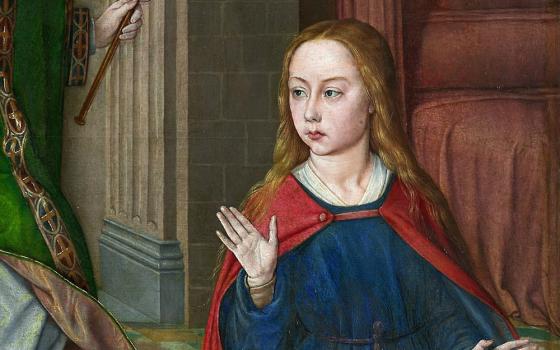Recently, I was remembering the "May Crowning" processions of my childhood, and how as an adult I often wondered how to relate to Mary. In the Marian year* in preparation for the millennium, I began to consider Mary as a role model for what I call "authentic spiritual leadership," as I was teaching on the relationship between spirituality and leadership development. I still use Mary to illustrate the importance of that relationship.
Stop and think about what makes a person "authentic." Now, do the same with someone you would call "spiritual." Finally, think of what characterizes a good "leader." Are there any traits in common on those lists? Keep them in mind as we explore Mary's authentic spiritual leadership.
There is a foundational insight into Mary's leadership style in Luke's account of Jesus' birth — the dramatic tale of shepherds bringing news of an angel declaring Mary's child to be the long-awaited Messiah. The narrative ends with this line:
Mary treasured all these words and pondered them in her heart (Luke 2:19).
Was Mary's "pondering" mentioned here a singular event, stirred by the incredible tale told by the excited shepherds?
This is not the only scene in which we see Mary "pondering." I think that Mary "pondered" as a spiritual practice throughout her life. She must have allowed herself moments of quiet reflection, contemplation, wonder and awe at the greater mystery of which she found herself often only an unknowing part.
These moments of contemplation also deepened her relationship with God, as we will see in considering an earlier Scripture passage:
"The Lord is with you. ... You have found favor with God" (Luke 1:28, 30)
Luke begins his Gospel with the story of the Annunciation. Here, we find the first evidence of Mary's engagement in faithful, lifelong openness to God's call through a contemplative spiritual practice.
In the story, an angel visits Mary and announces that she has "found favor with God." This passage reveals that the Annunciation is not the result of a spur-of-the-moment decision on the part of God. God did not say suddenly one day, "Let me look down to Earth and see if I can find a suitable virgin for my plan."
Rather, what happened in this story must be understood as the result of a long, ongoing relational presence and knowing between Mary and her God, an "at-one-ment" that had developed through a process of ongoing spiritual contact and communion.
Each of us knows persons like this in our lives: authentic, spiritual people who seem in tune with what is "really real" about life, and for whom sometimes remarkable things happen. We admire them, and we seek to follow them. Yet, being one is not an easy journey.
But she was much perplexed by his words and pondered what sort of greeting this might be (Luke 1:29).
As the scene continues, the angel announces Mary's unique mission to bear the Christ Child, and again Mary ponders her experience. She does not react precipitously to the angel's message, but weighs its implications, not accepting its possible truth quickly without careful thought and reflection.
If you have spent time in a leadership position, you know that leaders often are called to do the difficult thing. Those moments call for pause and reflection, to be certain that your proposed action is indeed rooted in the Spirit.
"Do not be afraid, Mary" (Luke 1:30).
Fear is the most universal response to change and the unknown that it heralds. In this passage, the angel calls Mary by name. She is known. This is a sign that a mutual knowing, achieved through her relationship with God, is the bedrock of Mary's trust in God — that trust that enables her to overcome fear and accept the challenge offered.
Reflection on past experiences of trust, and their positive outcomes, is an important practice of spiritual leadership, and leads to commitment to serve.
"Here I am, the servant of the Lord" (Luke 1:38).
In her ultimate response to the angel, Mary acts out of her knowledge of God's gratuitous love. She chooses to do the loving thing herself, to be a servant to others. She is open to doing the difficult thing for the sake of the greater good. Her experience of a loving God helps her overcome the instinct for self-preservation.
Her first task of service is to visit her cousin Elizabeth — also with child — who upon seeing Mary declares:
"Blessed is she who believed" (Luke 1:45).
Dutch feminist theologian Catharina Halkes in 1993 discussed Mary's response inspired by belief and its implications for all of us:
In Mary the people of God was again given the possibility of recognizing that God is acting here and now and that they also have to act in obedience to the call and thus follow into the unknown. Here believing means making oneself available.
However, it is not enough simply to believe in a vision that might bring new life to an organization. The leader also must learn how to remain centered and steadfast amid the consequent tensions, to confront past behaviors, to cope with resistance to change, to move forward at the right speed, and to "trust the process" rather than seek to control the outcome. We find an example of Mary navigating these tensions in another Gospel passage.
"They have no wine" (John 2:3).
At the wedding feast at Cana, we find two important elements of Mary's leadership style. In his "The Gospel According to John," C.M. Vawter suggests that Mary may have been a guest of some authority at the feast, perhaps a near relative. She certainly knows, once she learns of the problem, that the young couple and their families will be embarrassed by the lack of wine.
Her deep compassion for the needs of others sends her to the one she knows will be able to help. Then, she simply defines the unfortunate reality, saying to Jesus: "They have no wine."
Jesus responds with a deflection: "Woman, what concern is that to you and to me? My hour has not yet come."
Mary, however, is neither engaged nor dissuaded by Jesus' resistance. Instead, with calm authority, she turns to a servant and instructs him, "Do whatever he tells you."
Then — and equally important — Mary disappears from the narrative altogether, thereby showing the true strength and wisdom of authentic spiritual leadership. She first empowers Jesus to move beyond his own resistance, and then leaves him free to respond. Having completed her leadership role, Mary moves out of the way and into the background, allowing Jesus and the servants to manage the situation on their own.
This portrait of Mary illustrates what I see to be the important connection between spirituality and leadership development. Without the ongoing "inner work" of spiritual development, one cannot hope to be a leader free to say "yes" to the call of the Spirit, compassionate toward the needs of others, and courageous in the face of resistance. We have a role model for our own leadership as women religious.
*An earlier version of this column gave an incorrect year.
[Patricia M. Bombard is a member of the Sisters of Charity of the Blessed Virgin Mary of Dubuque, Iowa. She has a doctorate of ministry, has worked in various capacities in the areas of business, politics, journalism and higher education administration, and taught at St. Xavier and Loyola Universities in Chicago. She is currently directing DePaul University's Vincent on Leadership: The Hay Project.]
Editor's note: Some of the material in this column originated as a breakout session for Mary 2000, a symposium in honor of the Blessed Virgin Mary held in Chicago in September 2000. It also was adapted for part of an oral panel discussion at the College Theology Society in 2003.

